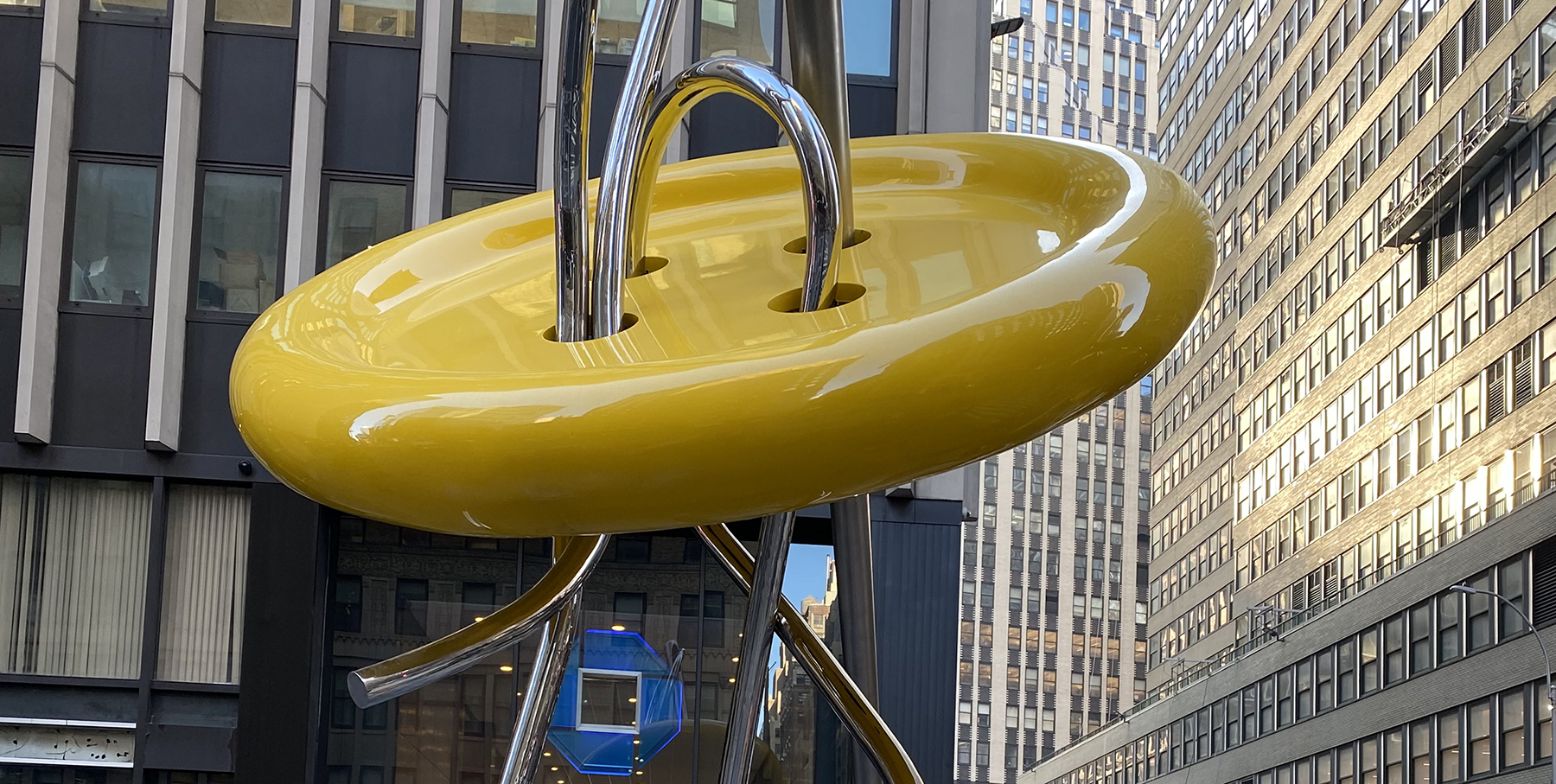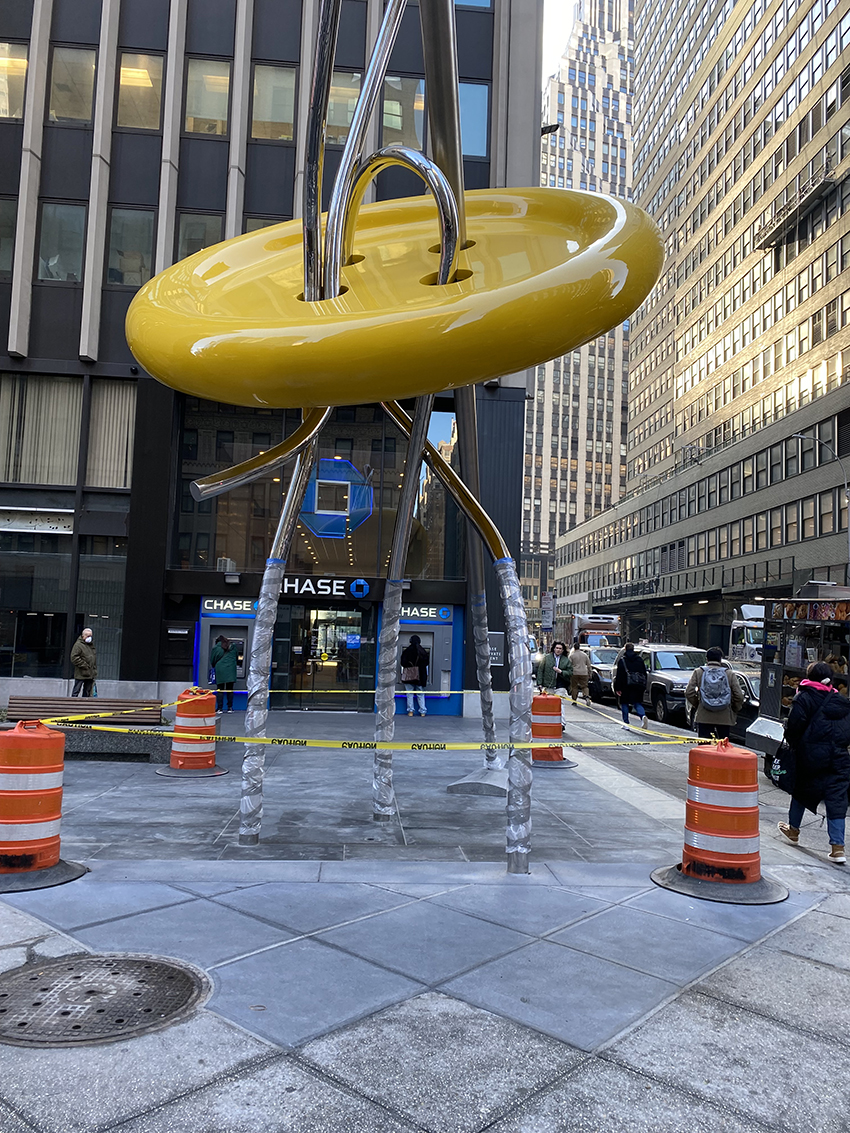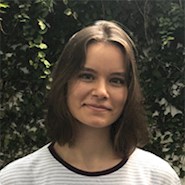By Leslie Nemo
Even though hundreds of workers no longer commute to the Garment District daily to stitch the latest fashions, the icons of their trade loom large in New York City. More specifically, they loom as a 15 ft wide aluminum button seemingly held aloft by a 32 ft long stainless steel needle and its three attached strands of thread.
The sculpture of the oversized sewing equipment debuted at the intersection of Seventh Avenue and 39th Street in February. Commissioned and funded by the Garment District Alliance, a nonprofit dedicated to the city neighborhood, the silver-and-yellow design needed $1.5 million and the expertise of experts from architects to artists to city officials.
“I think it’s really interesting the way it’s supported,” says Susan Kosor, senior project manager at art design and assembly firm Urban Art Projects. “You walk by, and nobody is thinking what all we had to do to make it work.”
The spot occupied by the new sculpture has served as a Garment District focal point for decades. In the 1970s, a kiosk on the plaza acted as a base for people to direct shoppers toward whatever fabric or clothing accessories they were after. In 1996, the GDA added an oversized button and needle sculpture, which appeared to balance on the kiosk.
More than 20 years later, the GDA hired Local Projects, a design studio based in New York, to research what new structure would best serve the area. The organizations landed on a stand-alone button and needle sculpture. Executing that vision meant a design-assist contract with UAP and an agreement with Biber Architects, a New York-based firm helmed by James Biber, the designer of the original button and needle.
Swapping fiberglass for steel
Originally, the designers and engineers hoped to reuse Biber’s original fiberglass button. However, it proved to be too cracked to reuse. In addition, the shape of the original button element would have made executing the stand-alone sculpture challenging, says Tim Franklin, owner of structural engineering firm Theta Consulting, the engineer of record on the project.
Discarding the existing elements allowed for a durable replacement — an aluminum button paired with stainless steel needle and thread — that UAP fabricated in its Shanghai studios.
After a few design iterations that guaranteed the structure had enough head space above the ground level to meet Americans with Disabilities Act requirements and used only materials that could be reasonably sourced, the final rendition includes a button with beams radiating inward from the edge and a lattice support structure in the center. Welding and polishing of the surfaces created a flat surface for the button.
The threads don’t actually extend through the button “holes” but instead comprise separate elements that are bolted onto either the top or bottom of the button to create the illusion that they thread through, Franklin says.
The goal to hide the connection points and supports extends all the way into the ground.

A majority of the sculpture sits on property managed by the real estate firm Hines and benefits from being able to attach to the existing steel support beams that cross a basement ceiling immediately beneath the plaza.
With about 3 in. of depth to work with — anchoring had to fit between the ceiling of the basement and the plaza pavers — Theta opted for a dunnage support system to create the structure’s hidden steel foundation. At each connection point with the ground, parallel bars of steel dunnage support two perpendicular hollow structural sections. The HSS support a baseplate, which workers bolted the thread and needle tips into.
Public participation
For the project to be a public-private partnership, part of it needed to extend off the Hines plaza, says Brendan Kelly, P.E., principal engineer at McLaren Engineering Group, which UAP contracted for civil and structural engineering work.
For this, McLaren mapped where the basement ended and public property began. As a result, a single thread connection point goes past the private property of the basement parameters and into public property. The process also provided for Theta information on where existing steel support beams underground could offer a foundation for the dunnage.
Siting one of the threads on public land also meant figuring out where the attachment and its concrete pier, which the dunnage is bolted into, could slot into the packed underground of New York. “Ironically, this project was kind of like threading a needle in the placement of this footing,” says Tim Noordewier, P.E., PTOE, project manager with McLaren.
Available space sat near a subway tunnel, so McLaren worked through permits and tests to prove construction wouldn’t interfere with the integrity of the transit system. The investigation included the city’s Department of Environmental Protection records, property documents, ground-penetrating radar, and vacuum boring — machinery that sucks up dirt to collect any detritus digging might dislodge — and revealed infrastructure that wasn’t documented, such as a sewer line and a brick wall remnant. (The latter is likely left over from a prior building on-site and required its own tests from McLaren to confirm it could be left alone without consequences.)

The simplicity of the sculpture’s appearance is deceptive, considering the excavations, permits, redesigns, and more that were necessary as part of the project. “We basically took an image of something and made it real,” Kosor says. “I don’t think it ever would have been easy. It's a fairly complicated piece.”



